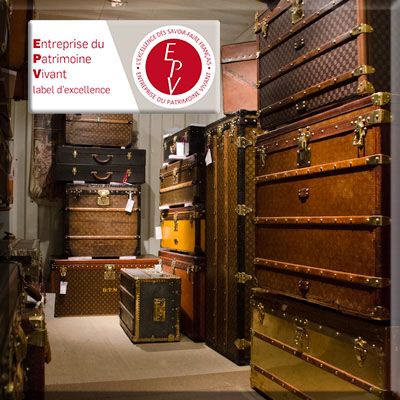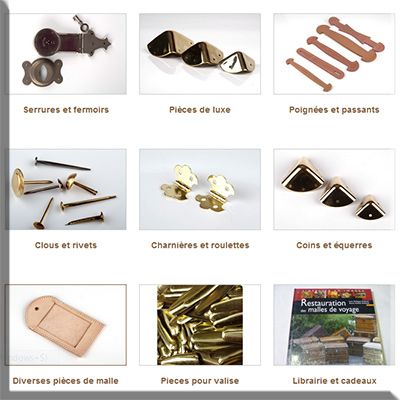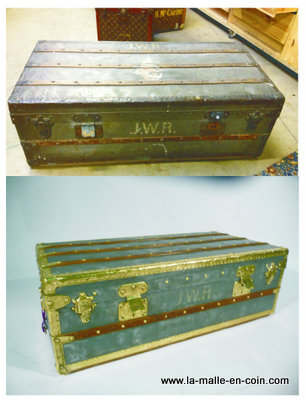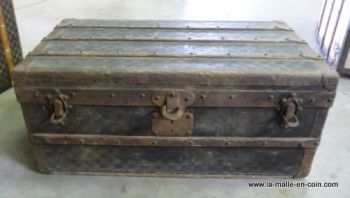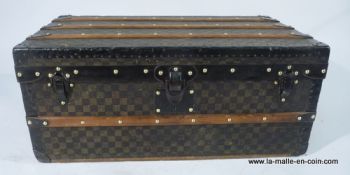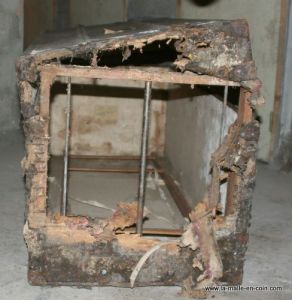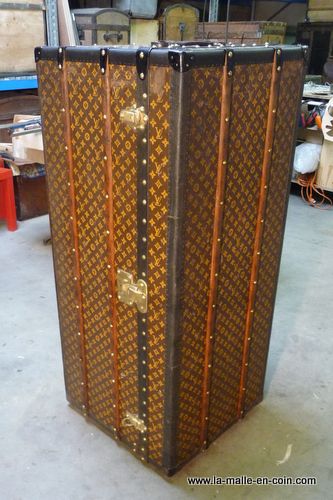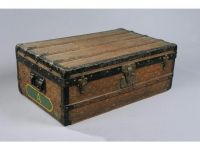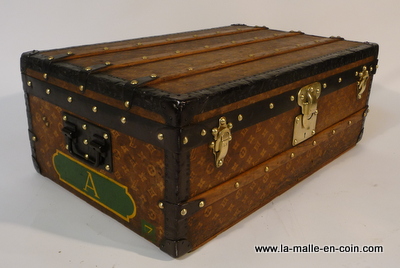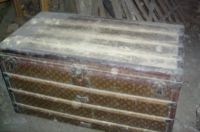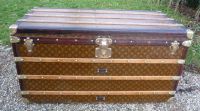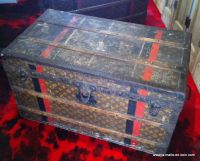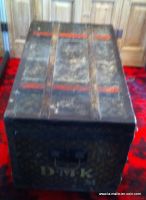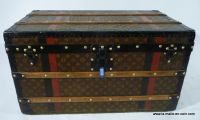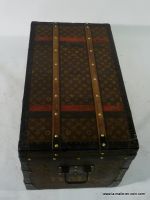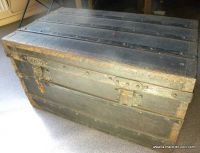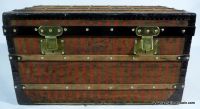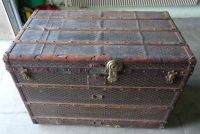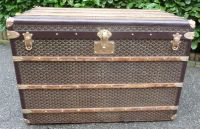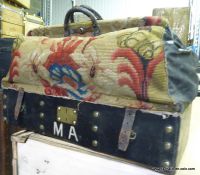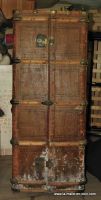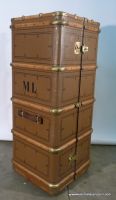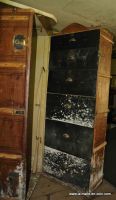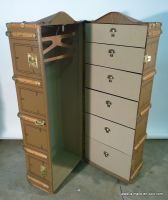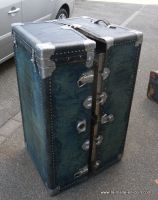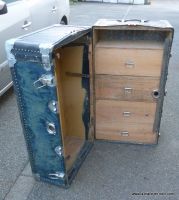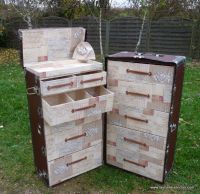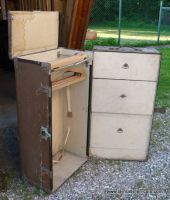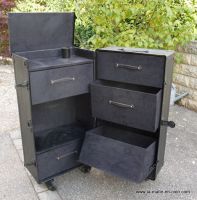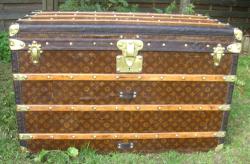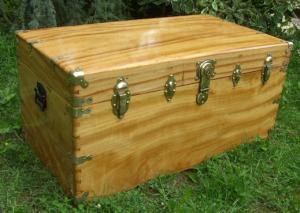Our restoration guide will give you detailed information… see more about it
Wood restoration
There are several methods to mend a damaged wooden part.
Each of them will be used depending on the seriousness and situation.
Be aware, however, that the less you do, most of the time, the better it will be.
Wood pulp
Ideal for filling small holes or on very small areas of damaged wood.
It can be stained and sanded but always tends to slightly retract when drying.
You need to put the wood pulp before sanding the trunk. You will put more than necessary, leave to dry for 24h and then sand.
Wood sealant
(Syntobois) Two-component, Syntobois wood sealant hardens when in contact with air and when the two components are in contact. When dried, it becomes harder than wood, it is ideal to do up a broken part. You can use it with a formwork in order to restore a specific area.
Use it for instance if the hinge area of your trunk is broken. It can be sanded and stained; it does not retract but tends not to take the right stain. It is often necessary to mix different colors to obtain the ideal one.
More tips are available by registering on the website. Create your account and please confirm via the e-mail you will receive.
Wood hardener
Wood hardener is a good solution for small worm-eaten areas that it will be better to keep rather than to replace. Directly apply on the area to be restored, before sanding.
Scarf joint and replacement of damaged parts
Scarf joint is a woodworking technique which consists in inserting a piece of the same species wood on a piece of furniture on which it is missing. That technique was commonly used by yesteryear trunk makers to repair a trunk wooden board.
In most cases, a new wooden part is used for replacing a backing slat or a bottom slat.
Most of the time, the bottom slats are attached over the binding and their replacement does not raise any particular problem.
You will only have, depending on how much authenticity you want, to replace the slats by true antique slats taken on an old cannibalized trunk (disassembled for parts).
Failing that, you will use new slats but, in that case, you will have to think of changing them all and ageing them to give them the required patina.
Re-building a tray
The tray is a kind of drawer that can be lifted and which is supported by wooden corners or by cleats. The tray can be found in most steamer trunks. There may be 1 to 4 trays. They are made of poplar. Nowadays, you can buy poplar plywood quite easily. You cut 4 wooden boards for the 4 sides: 2 for the width, 2 for the length. Be careful to measure your trunk and to reduce by 1 cm at least, all around in order to leave room for the future coating (of the trunk as well as of the tray). Then, in the same wood, you will cut four 3-to-4 cm wide sticks with the same length as the 2 small sides of the tray. Two of these sticks will be attached to both ends of the tray (underside), the other 2 will be attached at regular intervals. Once that done, you will coat the underside of the tray first, then both sides and you will end with the inside bottom. The small support sticks are thus between 2 coating layers (fabric, paper…)
Restoring brass, copper, bronze
It is hard to explain in writing how to brush and polish brass, but it is easy to explain what you must not do.
1. Never use products such as Miror on a trunk brass. Do not forget that, if brass will be cleaned, most often you will stain around the brass part. Leather is easily damaged by corrosive products, wood gets stained and canvas too.
2. Think of the scratches that a metal brush will make, and ban it!
3. Do not paint on brass! It is ugly and moreover, it blisters quickly as copper reacts.
4. A nice brass with patina does not necessarily need to be cleaned, why not leave it as it is?
5. When possible, treat the brass part once taken apart rather than fixed on the trunk.
The best way to clean brass is to use tepid water with a little soap, 000 steel wool and a lot of elbow grease and sweat. Next step will be polishing: first with a polishing paste which removes scratches, then with a finishing polishing paste. At each step, do not forget to take a different brush.
Metal restoring
There are several types of metal parts on a trunk. You can find steel, sheet metal and zinc, more seldom wrought iron. Most often, the parts to be replaced are the sheet metal bottom of a trunk, or all or any of the corner metal ornaments. When it is the bottom part, the easiest way is to buy a sheet metal piece and to be equipped with a hand nibbler. That tool will enable you to cut as you wish rather thick sheet metal, for a modest price.
Xylophene
Anti-insect treatment liquid. Of course it can be necessary to treat a trunk. But I advise you to use that product in moderation. On the one hand it can be allergenic and I advise families with toddlers against it, on the other hand, in some cases, it is not necessary.
You will not need it if the trunk has been stripped with soda, nor in the following cases:
- Your trunk has no sign of insect activity and you live in a flat in town
- The region where you live is spared from insect attacks
Should you need to use that product, wear a mask and gloves and do not forget to brush both the inside and outside of the part to be treated.
On this page, you will find some samples of trunks, before and after restoration.
That page is meant to show you, if necessary, that nothing is hopeless.
The mentioned prices are estimated ones for luxury trunks or trunks with a major restoration work.
We also undertake more simple restorations.
We need the 6 photos + dimensions by e-mail in order to give you a quotation.
Consider viewing our case studies, in the blog, for example:
Wardrobe trunk Case study N° 9
Hat trunk: Case study N° 4
Red striped trunk: Case study N°10
See more examples on PINTEREST
You can enlarge the photos by clicking on them.
Louis Vuitton Damier trunk
Louis Vuitton wardrobe trunk after 15 years in a wet cellar
Louis Vuitton cabin trunk, woven canvas
Louis Vuitton steamer trunk 110 cm
When leaving the barn…!
About 50 hours needed
Steamer damier trunk (among other things, mending of the bottom right hole)
Malle Louis Vuitton courrier monogram
Initial state: moldy slit canvas, damaged wood with missing parts
Vuitton striped trunk
Restoration by Musée du Bagage
Goyard trunk belonging to Mr. L from Luxembourg (rebuilding)
Mrs. D. M-V Vuitton bag 1860
- Repair of valance and lock (existing but destroyed)
- Mending of the holes in the leather, dying of the leathers
Wardrobe trunk Mr SV
Mrs. B. wardrobe trunk
Creation of additional drawers on the left, new color fabric coating
Wardrobe trunk for a shop
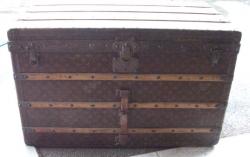
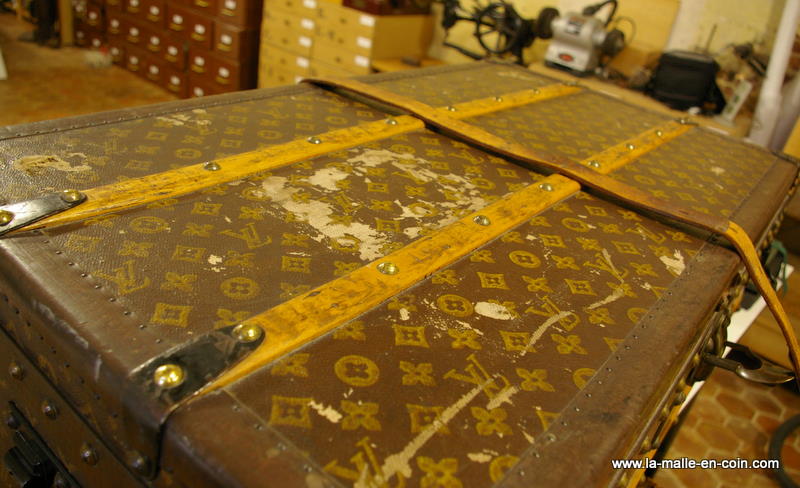
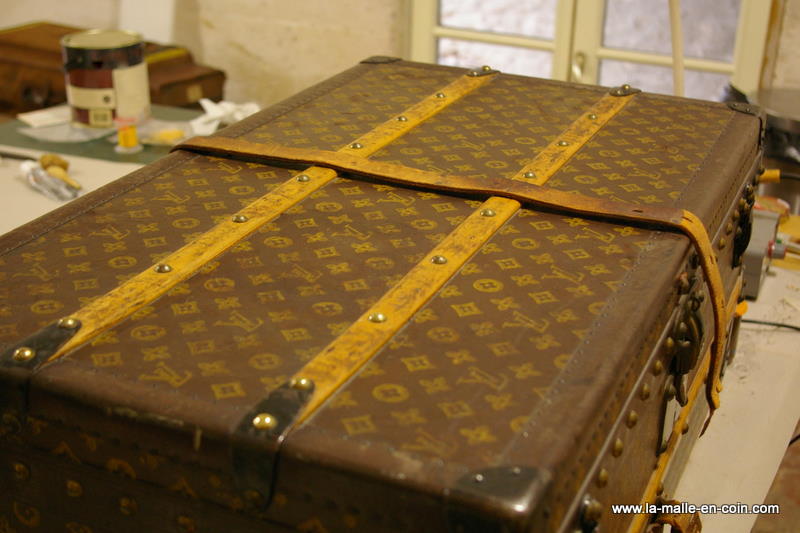
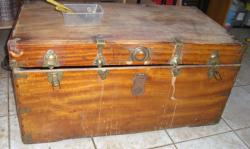
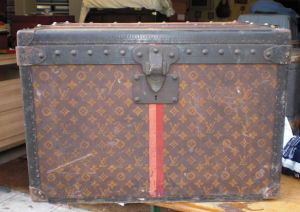
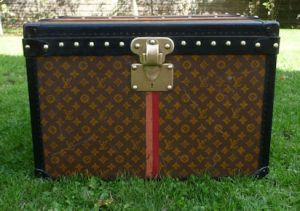
Before: no monogram. After: with a nice woven canvas
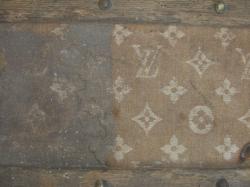
More restored examples…? See next page with more classic trunks
Using the trunk creation tool
The below utility aims at helping you designing the trunk with as much realism as possible.
With the utility you can either:
- Configure a trunk for asking us its carrying-out price
- Or use the utility to size your kit trunk.
With the proposed utility, you can:
- Choose the interior or exterior coating of your trunk (leather, imitation leather, canvas coated or not according to the use)
- Choose the color and material for corners, handles, bindings.
In order to size your trunk, USE THE CURSORS.
Do not hesitate to use the ZOOM in and out to better see the details.
The obtained sketch can still be touched up; you can ask us:
- A specific interior fitting out
- A different positioning of the locks and jewelry
- Customized canvases printed FOR YOU
Back to the application
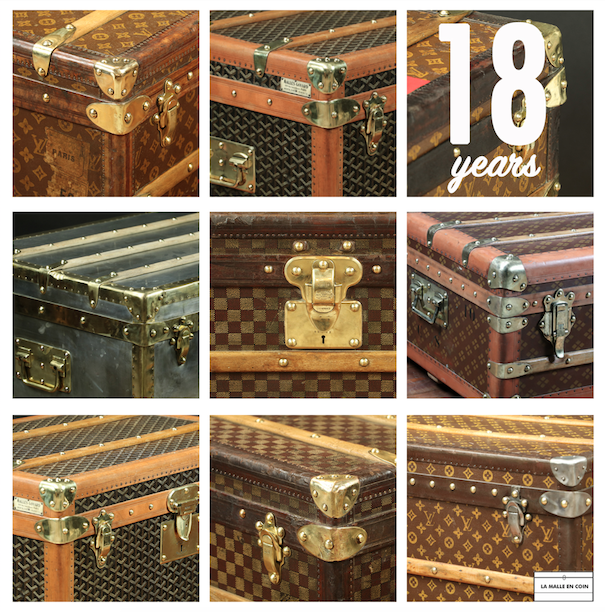 La malle en coin : eighteen years of experience and passion for trunks restoration !
La malle en coin : eighteen years of experience and passion for trunks restoration !
➡️ Visit our blog and see, for example, how to restore a Goyard trunk…
➡️ Watch our videos on how to restore a simple, common trunk.
➡️ Find our best tips on our Youtube channel.
➡️ If you wish to read a guide on how to restore trunks, you can find our book (in french) "Restauration des malles de voyage" with lots of pictures and advice.
⚠️CAREFUL : if the original canvas or leather can be re-used, preferably keep it!!!
The hereafter explanations only apply to low-value trunks, whose canvas is entirely destroyed, or which are in complete disrepair, preventing from re-using their canvas, or even which have an ordinary canvas that you find is not worth re-using. These explanations do not apply to Vuitton, Goyard, Moynat, Hermès trunks or to 100% leather trunks.
If you wish to keep the canvas or leather of your trunk for reuse, send us photos of your item and we will give you personalized advice by email This email address is being protected from spambots. You need JavaScript enabled to view it. or you can use the expertise and information form.
Preamble
The interior and exterior restoration of a 90 x 50 x 50 cm trunk will take about 14 working hours (for a normal DIYer, or more or less beginner). Apart from the machines (sander, drill for instance), you will have to invest around 100 euros in sandpaper, brushes, wood stain, wood grain filler, wax and interior canvas. A restoration work spreads over several days, so as to leave the stain or wax penetrate properly. Never sand a wet piece of wood.
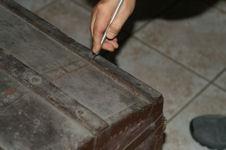
STEP 1 : Removing dilapidated canvas
To be done only if your trunk has a torn canvas and is of little value. If there is a doubt, send us photos for estimation. Do not take off the canvas of a luxury trunk (Goyard, Vuitton, Moynat Hermès). Do not try either to take off the canvas of a Cosmopolis-branded trunk (cardboard blank) or a Lavolaille one (metal bar under the canvas).
Use a box cutter, be careful to duly tilt it under the slats. Your free hand must always be placed BEFORE the hand that holds the box cutter. In case of skidding, your fingers will be thankful.
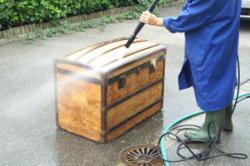
STEP 2 : Cleaning.
Most of the time, the collected trunks are dirty, smelly and dusty. A thorough clean-up, preferably on a sunny day, is essential.
If you do not have access to a high-pressure cleaner, no worries : a brush, a basin full of hot water and why not soap will enable to soften and to clean the glues and grime that accumulate over the years. Remember that your trunk is 100 years old!
IMPORTANT : Be careful to let your trunk to dry in the shade, in a ventilated area.
STEP 3 : Brushing the hardware.
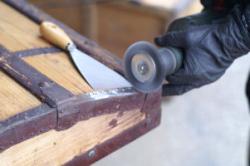
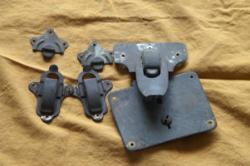
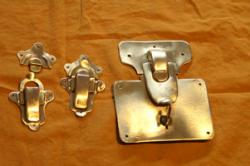 Example of a before/after metal ornament, detailed in our Restoration guide.
Example of a before/after metal ornament, detailed in our Restoration guide.
Example of disassembling : in the following example, the brass ornaments are very dirty. You will have to undertake polishing in order to restore and repair ornaments and locks.
- When reassembling, you must take great care not to damage them.
- Keep all the nails and untwist them in order to reuse them when reassembling.
- Don't hesitate to visit our shop for parts.
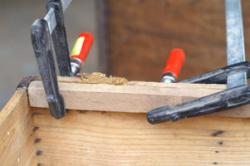
STEP 4 : Wood filling and repair, if necessary
Preferably use Syntobois rather than a too crumbly wood pulp.
Do not hesitate to create formworks if necessary.
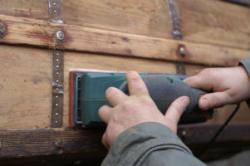
STEP 5 : Sanding the trunk
Details can be found in our Restoration guide. Usually we sand in 3 steps with a progressively finer grain, from grit 50 to grit 120 or 180, using the grit 80 in between. Always sand AFTER cleaning the hardware, in order to to be able to correct possible skidding.

STEP 6 : Sanding with fine grit.
Use finer and finer sandpaper, to end with around grit 120 (in case of a varnish – but we advise against varnish -, you will have to use even finer sandpaper, grit 240 or even 320).
STEP 7 - Treating the leather.
Not illustrated here. Neatsfoot oil is used preferably, but, if not, you can use Mixa baby milk which usually treats more delicate “leather” !
STEP 8 - Placing adhesive tape for hardware painting, if necessary.
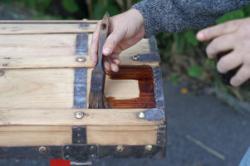
If the metal ornaments are naturally beautiful, be careful not to paint them. Prefer the use of a brush, and then wax to protect them. But if necessary, you can paint or simply dye in black, which is even better.
STEP 9 - Putting on cut sheet metal, in place of the old damaged ones.
Full details in the Restoration guide.
STEP 10 : Painting.
That is a matter of opinion ! But sincerely, I almost never use paint. We avoid painting trunks as much as possible.
STEP 11 : Staining the trunk
STEP 12 : Using the wood grain filler.
The wood grain filler makes wood impermeable to the following products such as varnish or wax that you might want to apply next. Once applied, the wood grain filler must be lightly sanded to smooth it. Thus you push back the wood fibers which have straightened with humidity.
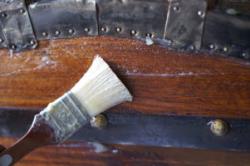
STEP 13 : Varnish or wax.
All types of varnishes are possible, but you can also wax and polish your trunk. More information in the Restoration guide.
STEP 14 : Fine sanding.
If you want a high-quality varnish, this step is necessary and can even be done twice. That method is used on trunks with large wooden areas and few metal ornaments.
STEP 15 : Top coat varnish
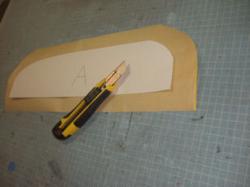 STEP 16 : Internal coating.
STEP 16 : Internal coating.
Detailed in the Restoration guide. The process consists in gluing the fabric on a very thin cardboard called “cartonnette” (in French) and used in framing works. And then, folding the edges on the back of that mounting board. You will do this folding in some places but not in others, in order to coat the corners without anybody seeing the wood. You should create a pattern for the bentwood banded, rounded or curved areas. You can as well create padded upholstery, redo an interior layout, re-create the interior trays for clothes, etc.
That step required in the book some plans that I cannot publish here, several dozens of photos and rather long explanations. During the training that we provide here in Haguenau, the coating of a trunk is a training that lasts a full nonstop working day. Therefore, be patient and ready to spend a little time on it.
What you need and how much will cost a complete restoration
Excluding the purchasing price of the trunk, costs will be around 80 to 100 euros.
➡️ Some examples below :
- Washing powder to wash and take off the canvas (washing powder with soda like St Marc)
- Cutter – Brushing the metal ornaments (1 wire brush, 4 euros, and 1 nylon brush, 7 euros)
- Sanding (sandpaper grit 50-80-120) 7 euros
- Wood pulp – Wood stain 15 euros per liter – Paintbrush 1 euro
- Wood grain filler 8 euros
- Sandpaper grid 360, 2 euros – wax (12 euros a tin )
- Strand cotton 2 euros – Fabric between 12 and 30 euros/m
- Thin cardboard 2 euros depending on your needs
- Varnish, sheet metal for repairing, paint for fixing a specific area, black stain, anti-scratch pad, wood, nails, hinges, leather handles, etc.
➡️ Moreover, it would be ideal if you had the following tools :
- Screwdriver, hammer, pincers, pliers... for the spare parts.
- Orbital sander, detail sander, electric file and drill for basic works.
The "Guide de la restauration des malles" (Pdf file for Trunks restoration guide, in French)
It is not printed anymore.
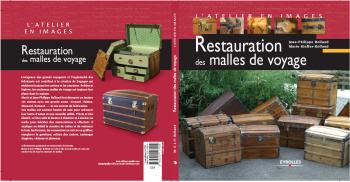
Here is a sample of the book's pages :
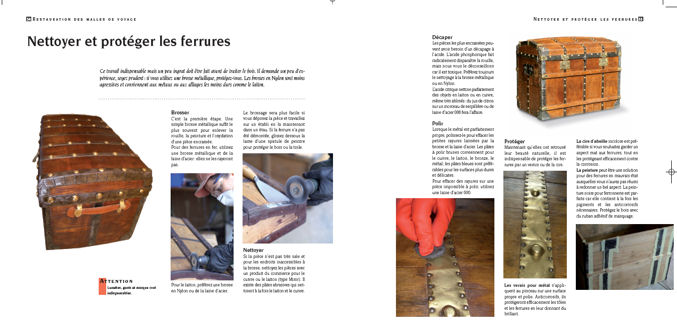
Leather is an important part in trunk creation or antique trunk restoration.
More often than not, you will need the following tools:
(They are examples only; of course the list is non-exhaustive)
- Marking pen for the patterns
- Skiving knife (to skive leather thickness where you need)
- Edge beveller (to remove the corners from your leather edges)
- Awl
- Punch
Etc.
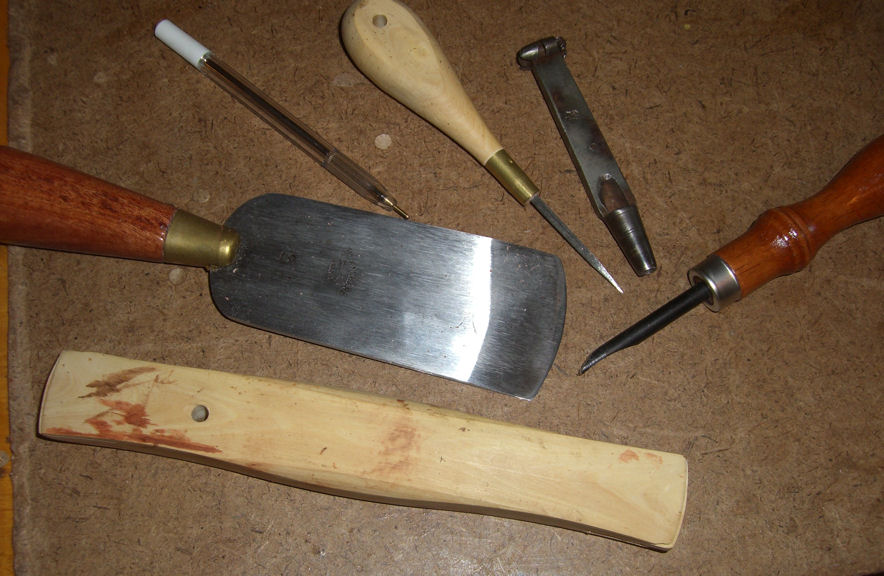
-
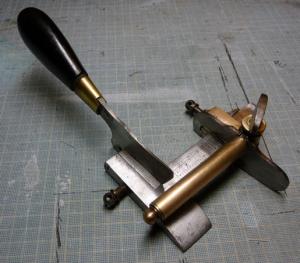
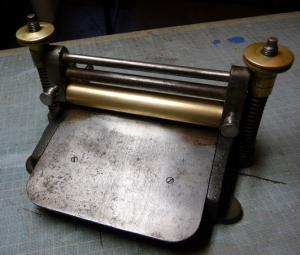
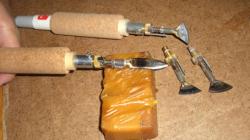
Details in : le guide de la restauration des malles de voyages
Creation of new leather handles
1 PATTERN
The shape you want to reproduce of course
You will use a special pen to write on leather.
2 CUTTING
In the raw skin
3 DYE AND DECORATIVE LINE
To be done slowly with small steps
4 GLUE
Stick together the leather pieces in order to put up the handles (from 1 to 3 layers, with or without a core)
5 CUTTING
6 CREASING IRON
7 COMPASS
8 PRICKING WHEEL
9 STITCHING
- With a saddle stitch
- Stitching clam, awl, waxed thread
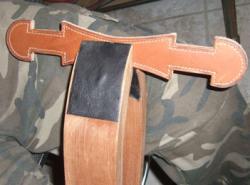
10 TAPPING (the stitches)
You tap the thread down
11 HEATED WAX WITH SPATULA
The wax spatula is screwed to an electric handle.
It enables to melt the wax and to apply it on the leather edges and only there.

12 CREASING IRON
See examples on the photos. The iron is screwed to an electric heating handle and enables to make decorative lines at edges of leather.
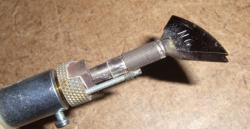
13 SANDING
Sand the edges, not the grain nor the flesh.
14 EDGES DYING
The product is purple but takes its final color on drying.
.
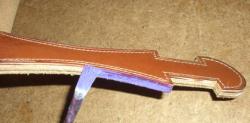
15 COLD WAX 1
16 POLISHNG
A tedious long task, but an important one
17 SANDING
A light sanding as for wood
18 WAX
19 BRUSH
But what does restore mean?
For us, there are several ways and solutions for antique trunk restoring.
The first way, developed in the below guide, is the best known and easiest one. It consists in re-creating, from an antique trunk in its original state, a decorative object diverted from its initial travel function. Such method should not be called restoration but rather repair given that the aim is not to restore the object back to its original condition, but to safeguard an old object by adapting it with our current decoration tastes. It is therefore to be kept for low value and/or of no historic value trunks and/or objects.
The second way, which we use but do not necessarily talk about in this guide, consists in looking for a refurbished configuration as close as possible to the original condition. Of course that method, often less demonstrative, is more delicate, for it consists in preserving as much as possible the object in its primary function and its original condition. It must be applied to valuable trunks and fine items that still have preferably the whole of their original parts.
Lastly the third way consists in reinterpreting in a current way the first trunk-makers’ objective. Indeed what were they doing? Creating a packaging around a specific item? Therefore, as objects have evolved, it can be necessary nowadays to adapt the packaging to the content. Is converting an old cabin trunk into a CD trunk not continue to practice the know-how that consists in creating a specific packaging for each need? Thus we can convert an old dome-top trunk into a hi-fi trunk, a harp trunk into a wardrobe one, a wardrobe trunk into a desk trunk, etc.
Isn’t that the idea of modern trunk-makers who create, for current needs, modern trunks in the old days’ spirit?
Subcategories
Contact
Email
info@la-malle-en-coin.com
Phone
+33 (0)3 88 93 28 23


